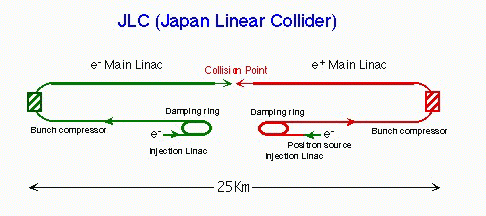
Above the 100GeV, however, the energy loss due to synchrotron radiation becomes significant if beams are bent, which makes a circular collider impractical from the view point of electric power consumption. In order to keep the power consumption reasonable, we need to increase the radius of the ring as the fourth power of the beam energy, which is again impractical from the view point of construction economy. JLC is a new kind of collider which consists of two linear accelerators (linac), one for electrons and the other for positrons, opposing each other to make the two beam collide at the mid-point. Since there are practically no curved accelerating sections in the JLC machine, there is no synchrotron radiation in principle. JLC is therefore power-efficient.
The electrons and positrons are first accelerated by injector-linacs up to 2GeV and are cooled in damping rings to make ultra-low emittance. They are then led through pre-accelerators to the main linacs and, at their ends, reach the maximum beam energy. These high energy beams are squeezed by a final focus system to a nano-meter level and finally collide at the interaction point surrounded by a detector system.

To next page, To previous page, To table of contents